'You've come a long way, baby'
Dukes celebrate 50 seasons of football this fall
News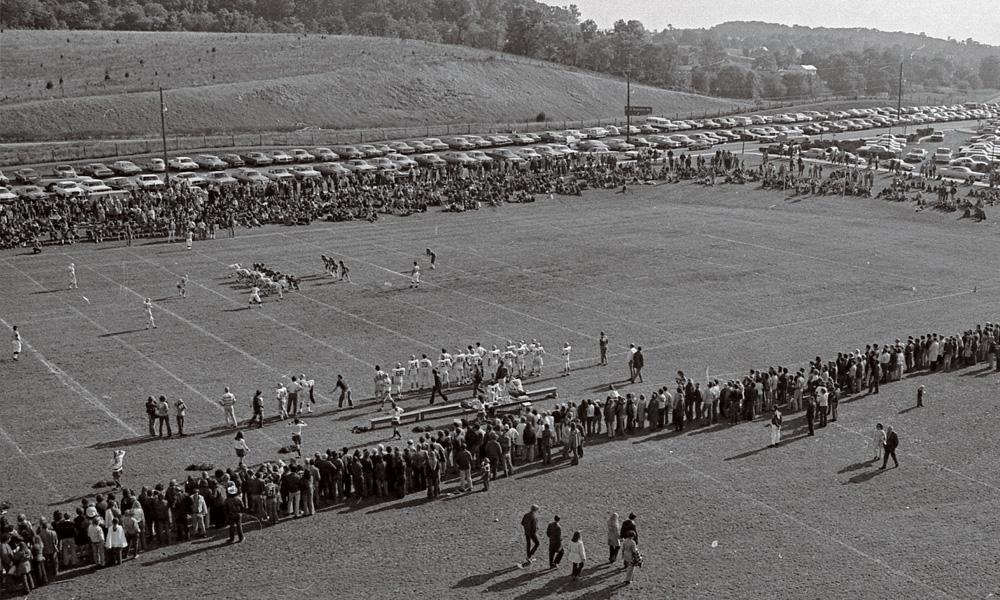
By Gary Michael ('77)
From a makeshift field with school administrators watching on lawn chairs to boisterous capacity crowds at a modern, on-campus stadium. From a scoreless season to winning two national championships and annually competing for others. From a roster recruited from class registration lines to a long list of professional standouts, including Super Bowl winners.
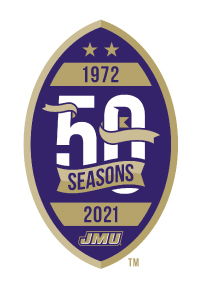 All are parts of JMU football, which will play its 50th season in 2021, and to borrow a phrase from the era of its beginning, “You’ve come a long way, baby.”
All are parts of JMU football, which will play its 50th season in 2021, and to borrow a phrase from the era of its beginning, “You’ve come a long way, baby.”
The Dukes have gone from a nonscholarship team to an elite NCAA Football Championship Subdivision program, one that has appeared in several national telecasts and twice hosted ESPN’s College GameDay.
JMU’s 2004 and 2016 teams won FCS championships, and the Dukes were 2017 and 2019 national runners-up. They’ve reached the FCS playoffs in each of the last seven seasons, 12 times since 2003 and 17 times overall. Numerous Dukes have had prominent pro careers, including Charles Haley, the first five-time Super Bowl winner and a member of the Pro Football Hall of Fame, and three members of Tampa Bay’s 2021 title team.
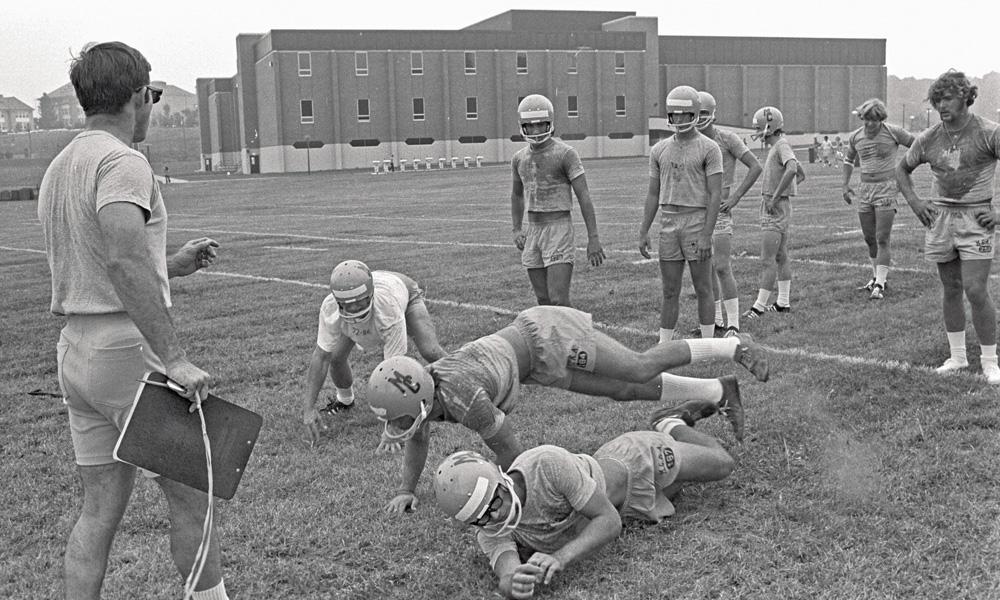 |
| The inaugural team's players were recruited from the class registration lines at the start of the 1972-73 school year. |
Program kickoff and early success
Few people in 1972 could have envisioned JMU football’s development. But creating widespread enthusiasm and demonstrating that then-Madison College was no longer a small, mostly women’s school was the goal.
Then-President Ronald E. Carrier, assisted by longtime athletic director Dean Ehlers, pushed football. In his book Building James Madison University, Carrier wrote: “To truly transform Madison College’s image with students, faculty, and the larger public, especially in the Central Shenandoah Valley, we needed to field a football team, a sure way to project that we now operated as a coeducational institution. Football could provide needed campus activities on autumn weekends and counter the mass exodus of students each Friday who perennially complained about dull, boring weekends at Madison, earning the college the unenviable reputation as a suitcase school.”
|
"To truly transform Madison College's image with students, faculty, and the larger public, especially in the Central Shenandoah Valley, we needed to field a football team, a sure way to project that we now operated as a coeducational institution." — Ronald E. Carrier, from Building James Madison University |
Because many opposed football, believing Madison’s image would change and resources would shift away from academics, the program’s launch was delayed until July. That left coach Challace McMillin just three months to prepare—and without players. The original members were recruited while registering for classes at the start of the 1972-73 school year, and many disappeared before the initial practice.
The first schedule included one varsity and two junior varsity opponents and two military school teams. The opener was set for Oct. 7 at Harrisonburg High School—now Memorial Hall—but rain left the field unplayable. Madison’s staff arranged a practice area beside Godwin Hall for play, with fans sitting in folding chairs or standing along the sidelines. JMU lost 6-0 to Shepherd College’s junior varsity team and remained scoreless throughout its 0-4-1 inaugural season.
The team improved to 4-5 in 1973 while playing two varsity programs and securing its first victory, 34-8 over Anne Arundel Community College. The 1974 team faced a full varsity slate and finished 6-4, setting up one of Madison College’s more memorable campaigns.
The 1975 Dukes opened with a scoreless tie at Glenville State but then ran off nine wins to finish 9-0-1, the program’s only unbeaten season. Madison allowed a paltry 75 points, and no game was decided by more than 11 points. Seven wins were by seven or fewer points, with most outcomes in doubt until the final horn. Madison won the College Division Virginia College Athletic Association with a 5-0 record.
The winning streak reached 12 early in 1976 when the Dukes were tied for first in the NCAA’s initial Division III poll. That week, they played at Hampden-Sydney in the first D-III game televised by a major network (ABC). JMU remained a D-III program through the 1978 season before awarding scholarships and moving to Division II in 1979 and Division I-AA (now FCS) in 1980.
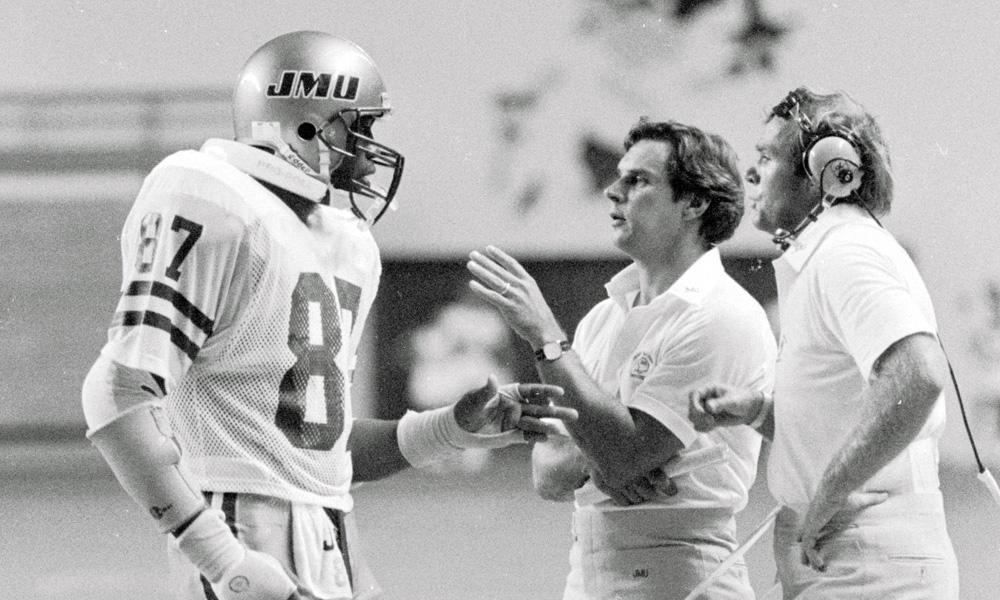 |
| Before Charles Haley ('87) became a Pro Football Hall of Famer, he was an All-American defensive lineman at JMU. |
Transition period and long-term success
The move to I-AA was challenging—back-to-back 4-6 records in 1979 and 1980, and 3-8 in 1981—but with four classes of scholarship players, the 1982 Dukes finished 8-3, including a 21-17 win at Virginia, where JMU’s seniors had lost 69-9 in 1979. Haley had an immediate impact in 1982 as a freshman defender, and the team also featured future Washington Redskins wide receiver Gary Clark and JMU’s career rushing leader in freshman Warren Marshall (4,168 yards). Clark had an 80-yard touchdown catch in 1982 at Virginia and punt returns of 89 and 87 yards for scores there in 1983.
JMU first reached the NCAA playoffs in 1987 after a 9-3 campaign under Coach Joe Purzycki. Rip Scherer led the 1991 and 1994 playoff teams, while Alex Wood, Mickey Matthews and Everett Withers directed the Dukes to postseason play in 1995, 1999 and 2014, respectively. All were first-year college head coaches. (More recently, Mike Houston (2016) and Curt Cignetti (2019) led the Dukes to the playoffs in their first seasons in Harrisonburg.)
JMU won at Division I-A Navy in 1989 and 1990, and Scherer’s 9-4 team in 1991 secured JMU’s first playoff win, 42-35 in double overtime at Delaware. The Dukes returned to the playoffs in 1994 and 1995 behind quarterback Mike Cawley, and the 1994 squad notched 10 victories—then a program record—and a playoff win.
The 1999 Dukes tied for the Atlantic 10 conference title—JMU’s first I-AA crown—and returned to postseason play. JMU opened at Division I-A national runner-up Virginia Tech and then won seven straight games behind Matthews, The Sports Network’s I-AA Coach of the Year. Matthews also was the A-10 Coach of the Year, and Curtis Keaton and Chris Morant were the league’s offensive and defensive players of the year, respectively. It marked the first time that one program received the league’s three major awards.
Matthews’ 2004 national championship squad was the first in I-AA history to win three road playoff games en route to a 31-21 victory over Montana in the title game. His 2006, 2007, 2008 and 2011 teams each reached the playoffs, and his 2010 squad received wide acclaim for its 21-16 win at nationally ranked Virginia Tech.
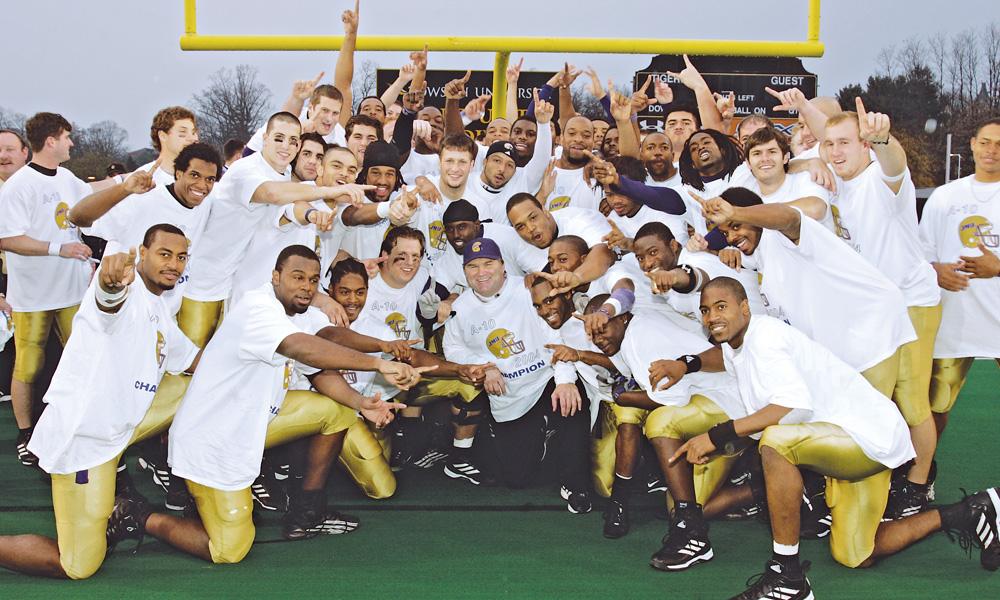 |
| Mickey Matthews' squad won three road playoff games before taking down Montana, 31-21, for the program's first national title. |
Few JMU home games can rival the excitement of the 2008 team’s under-the-lights rally from a 21-0 halftime deficit for a 35-32 win over three-time defending national champion Appalachian State. Those Dukes had a 12-game winning streak and were the top playoff seed, and Matthews received The Sports Network’s Coach of the Year honors a second time.
Withers’ 2014 and 2015 teams reached the playoffs, and Mike Houston in 2016 led JMU to its second national crown, defeating longtime FCS power North Dakota State on the road, 27-17, before taking down Youngstown State, 28-14, in Frisco, Texas, for the title.
The Dukes returned to the FCS title game under Houston in 2017 and again in 2019 under Cignetti, and remain an FCS powerhouse. JMU has a 76-16 record during the last seven seasons, including 58-9 during the last five, and is 45-6 in conference play during that span. The Dukes have won or shared their league title eight times since 1999, including five of the last six seasons.
On the horizon
The level at which the team competes is a topic of conversation. Compete where you have been successful or transition to what some consider a more appropriate level? The answer is never easy. But considering the development and success of the program since 1972, JMU is well positioned for whatever the future holds.
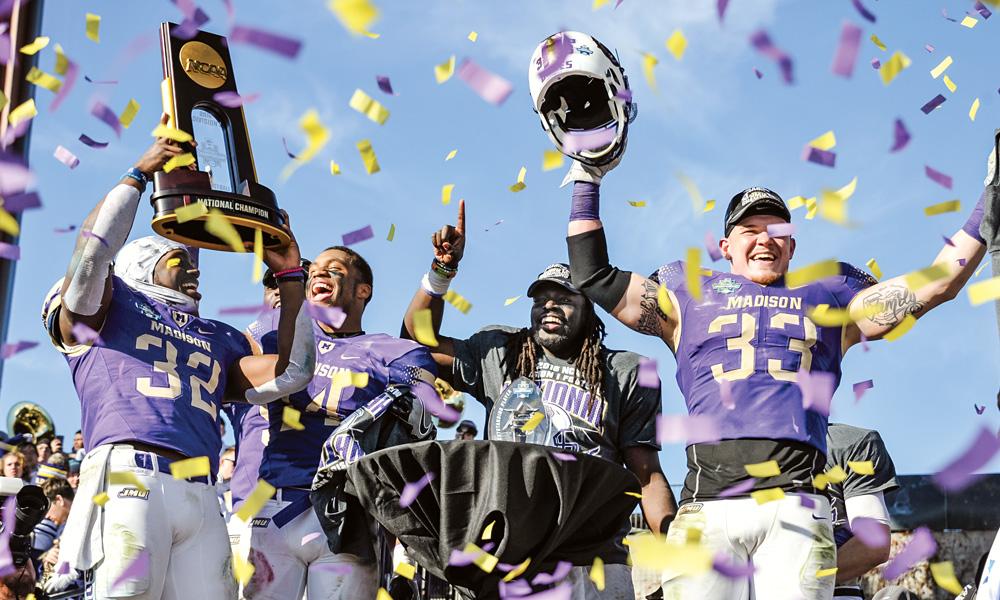 |
| Purple and gold confetti rained down on members of the 2016 team after their win over Youngstown State in the FCS Championship game in Frisco, Texas. |
Star power
The names Charles Haley, Gary Clark and Scott Norwood are most often mentioned in discussions of JMU football, but 49 seasons have produced numerous other standouts.
Quarterback Les Branich and offensive lineman Jeff Adams were early cornerstones and lettered from 1972-75. Defensive lineman Woody Bergeria and linebacker Dewey Windham were early All-Americans, and tailbacks Ron Stith and Bernard Slayton compiled remarkably similar statistics from 1973-76, both rushing for more than 2,000 yards.
Norwood enrolled in 1978 and became a leading I-AA placekicker; Clark arrived in 1980; and Haley and Marshall, who became the top rusher in Virginia college history, arrived in 1982. Haley was JMU’s first Associated Press First-Team All-American in 1985 and the following year became its first NFL draftee (San Francisco, fourth round). Clark was chosen sixth in the 1984 United States Football League Draft and later won two Super Bowls as a Washington Redskin.
Cawley threw for 6,482 yards and 42 touchdowns in three years for the Dukes, and Eriq Williams, a top performer on the 1991 playoff team, threw for 5,356 yards and 40 scores and had 7,678 career yards of total offense.
Safety Tony Booth, return specialist Delvin Joyce and Keaton were late-1990s standouts. Booth twice received All-America honors and had a 122-tackle, eight-interception season in 1997. Joyce surpassed 1,000 career yards for rushing, receiving, punt returns and kickoff returns and had a successful career with the New York Giants. Keaton ran for 2,783 yards in two JMU seasons and was a fourth-round NFL Draft choice.
Linebacker Derrick Lloyd led the nation in unassisted tackles in 2001, winning The Sports Network’s Buck Buchanan Award as I-AA’s top defender after compiling 157 overall stops, 7.5 quarterback sacks and five fumble recoveries.
Safety Tony LeZotte, in 2005 and 2007, and linebacker Akeem Jordan, in 2006, were league Defensive Players of the Year, and quarterback Rodney Landers and return specialist Scotty McGee were 2008 league Offensive and Special Teams Players of the Year, respectively. LeZotte was JMU’s first four-time All-American, and center Scott Lemn won the 2008 Rimington Award as FCS’s best center.
Defensive end Arthur Moats won JMU’s second Buchanan Award in 2009 after leading the FCS in tackles for loss and its down linemen in tackles. He and Jordan, the 2006 College Sporting News Defensive Player of the Year, enjoyed extended NFL careers.
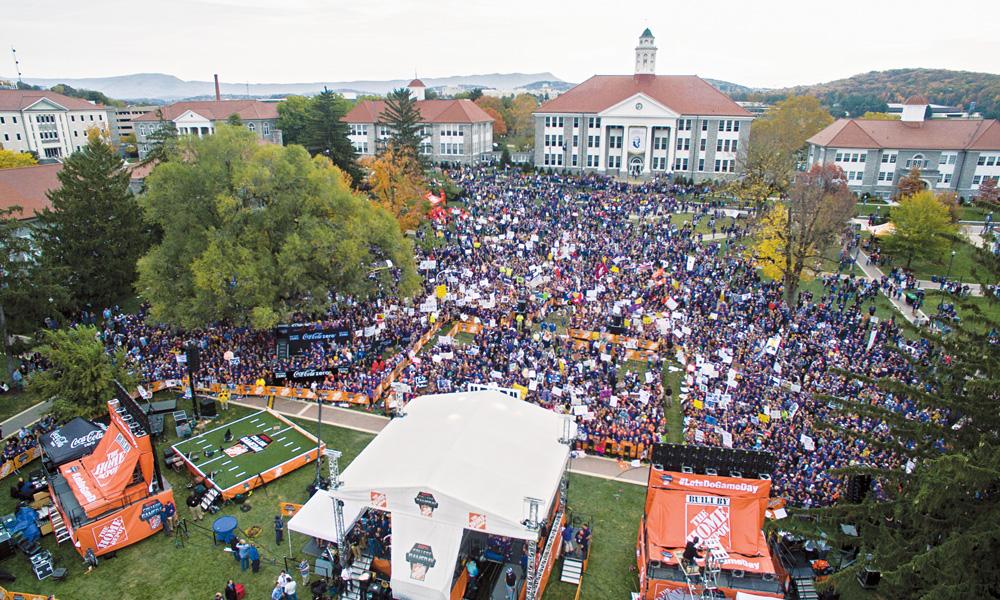 |
| ESPN came to campus twice, creating unforgettable moments for students and other members of JMU Nation to revel in. |
As JMU has dominated as a program during the last decade, individual accolades have flowed in. Dukes receiving league Defensive Player of the Year honors have included linebacker Stephon Robertson (2012, 2013), lineman Andrew Ankrah (2017), cornerback Jimmy Moreland (2018), lineman Ron’Dell Carter (2019) and lineman Mike Green (2020-21). Ankrah won FCS 2017 Defensive Player of the Year plaudits by the FCS Athletics Directors Association.
Quarterback Vad Lee, who in 2015 at Southern Methodist became the first D-I player to rush and pass for 275 yards in a game, was league Offensive Player of the Year that season, and Bryan Schor and Ben DiNucci won the award in 2016 and 2019, respectively. Kick returners Rashard Davis in 2016 and John Miller in 2017 and placekicker Ethan Ratke in 2020-21 were league Special Teams Players of the Year.
Davis (Philadelphia), D.J. Bryant (Baltimore), and Aaron Stinnie, Josh Wells and Earl Watford (Tampa Bay) have been on recent Super Bowl winners.
Conference affiliations
JMU was a 1974 and 1975 VCAA member and then an independent until playing its first game in the Yankee Conference in 1993. The Atlantic 10 assumed the Yankee’s operations in 1997, and the teams transitioned to the Colonial Athletic Association in 2007.
Playing sites
After the local high school field was too wet for JMU’s first game, it was the team’s home for the remainder of 1972 and 1973. Play moved to Bridgeforth Stadium/Zane Showker Field in 1974 on the first synthetic football surface in Virginia and with temporary seating. The current stands adjacent to Godwin Hall were added for the 1975 season and a similar arrangement across the field for 1981. The stadium’s first video board was installed in 2004, and the Robert and Frances Plecker Athletic Performance Center opened in 2005 and the current Lakeside stands in 2011.
Former JMU coaches
McMillin coached JMU for 13 seasons (1972-84) and remained with the university as a faculty member and with athletics in a sports psychology role. Purzycki (1985-90) became a successful business executive. Scherer (1991-94) left to coach Division I -A Memphis, and Wood (1995-98) went on to become the Minnesota Vikings’ quarterbacks coach, Withers (2014-15) departed to coach Texas State, and Houston (2016-18) left to coach East Carolina. Matthews recently has worked as a college assistant and remains JMU’s winningest coach with a 109-71 record.

